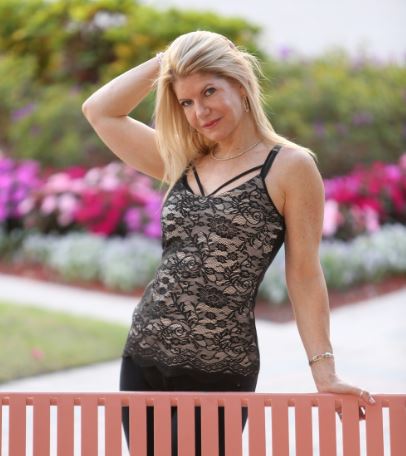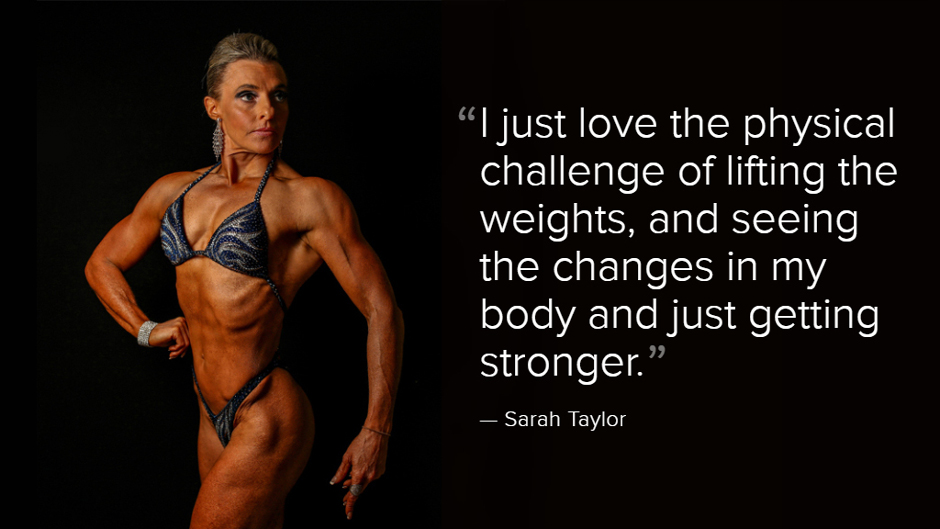
Female Bodybuilding is becoming increasingly popular among women(and men love it too). Here are some women who share why they pursue this sport so passionately and with so much dedication. It is inspiring and empowering and I hope you enjoy this article. -Lori Braun
New female bodybuilding categories in the past decade have meant women with a more natural-looking fitness physique can get bronzed up and be celebrated on stage, moving away from long-held stereotypes that conjure images of steroid-pumped muscle women that resemble the Hulk.
So what’s the appeal?
Bulking and blinging up
It’s two weeks until Sarah Taylor’s next competition. She is currently at 7 per cent body fat.
“My legs are looking awesome,” she says as she stares at her glowing orange groin area in the reflection of the gym mirror.
“I did a photo shoot for my 42nd birthday … At that point I’d never thought of bodybuilding. Ten weeks later I won the state novice title.”
-Sarah Taylor
“We all love our mirrors. Well, we can either love them or hate them. Depends if we’re having a fat day.”
Layers of fake tan accentuate countless hours of hard work.
Six years ago the 46-year-old Melbourne woman was classified as obese.
A relationship breakdown and a period of depression drove her back into fitness.
But like many competitors, the bodybuilding part came by accident.
“I hired a personal trainer and then I did a photo shoot for my 42nd birthday and the photographer thought I was competing in a bodybuilding competition,” she says.
“At that point I’d never thought of bodybuilding. Ten weeks later I won the state novice title.”
Four years on, Taylor is feeling in the best shape of her life.
“I just love the physical challenge of lifting the weights, and seeing the changes in my body and just getting stronger,” she says.
“You can never be perfect, there’s always something else that needs changing and I like that challenge.”
“I have competed in some federations that don’t do drug testing and I’m not big enough. You can see the difference.”
-Sarah Taylor
Her body today, she says, has been achieved through natural and legal means and through a fine-tuned regime tailored to how her body responds to exercise, fuel and rest.
From carefully portioned meals spread throughout the day starting with meat for breakfast, to five or six weightlifting sessions a week planned around strict sleep times, Taylor has come to live and breathe the sport.
Her diet is relatively the same year-round. She allows herself one “cheat” meal a week – usually steak and chips or pizza.
A healthy body fat range for females is considered to be between 18 and 25 per cent.
So while getting down to just 7 per cent can be dangerous, Taylor says for the five months leading up to competition season she gradually sheds fat and fluids so she is at her leanest on show day.
“Coming in to competition I’ll very gradually reduce my food,” she says.
“A weekly change could be as small as remove two almonds from my afternoon snack, or only have half a banana after my afternoon workout.”
Every eight weeks she has four days off to allow her body to recover and grow.
This dedication has seen Taylor win world championships in the figure category in Boston and Los Angeles, and will next month take her to Las Vegas for the PNBA Natural Olympia.
“I love the bling, most of it’s cheap costume make-up, the stripper heels. I love my sparkly bikinis. Once I get the fake lashes on and the nails, I’m ready to go.”
Sarah Taylor
There are several bodybuilding leagues in Australia. Some are drug-tested. Others are not.
ANB and INBA athletes can be tested by the Australian Sports Anti-doping Authority (ASADA).
The other two leagues, the IFBB and NABBA, are not drug tested.
While Taylor is large for a natural athlete, she says she generally sticks to competitions that test for banned substances such as steroids and hormones.
“I have competed in some federations that don’t do drug testing and I’m not big enough,” she says.
“You can see the difference.”
An IT business analyst by day, there is a huge and somewhat costly transformation involved in getting ready for the stage.
After registration, hair, make-up, several spray tans and a glittery costume, a competition can cost $2,000 a pop.
“It’s just a whole other world, it’s so different from who I am at work,” Taylor says.
“There are many, many blokes out there that … appreciate muscles. Strong is the new skinny which is the new sexy.”
-ANB general secretary Murray Graham
“That’s what I love about it, I love the bling, most of it’s cheap costume make-up, the stripper heels. I love my sparkly bikinis.
“Once I get the fake lashes on and the nails, I’m ready to go.”
In some federations, Taylor says, women are still the sideshow.
And while there is still a large gap in prize money across the board, other leagues are realising that women are driving the industry.
According to Australasian Natural Bodybuilding (ANB) officials, 60 per cent of competitors at their most recent nationals competition in Melbourne were women.
Strong is sexy
In Australia, natural female bodybuilders compete under four categories.
Ordered from the biggest build to the leanest, the classes are bodybuilding, figure, fitness and bikini.
“It is phenomenal. Now there are more women getting into it than what there is with the men,” ANB general secretary Murray Graham says.
“It’s not only what it does for their strength, it’s what it does for their mind. It empowers them.”
-ANB general secretary Murray Graham
Except for the bodybuilding category which is judged the same as the men, all of the categories include femininity in their criteria.
The introduction of the bikini category in the past decade has been credited by some in the industry for the huge influx of female interest.
Undoubtedly there’s a greater acceptance of a more athletic female physique and women competing at an elite level in male-dominated sports.
Just look at the Facebook page of athletes such as UFC fighter Ronda Rousey. Or the huge traction of fitness social media hashtags like #chickswholift and #strongisthenewskinny.
Graham says there is also a changing attitude about what is sexy.
“There are many, many blokes out there that … appreciate muscles,” he says.
“Strong is the new skinny which is the new sexy.
“[Female bodybuilders] are athletes in their own right and they want to be the best at what they do. It’ s no different to someone who wants to be the best woman golfer.
“It’s not only what it does for their strength, it’s what it does for their mind. It empowers them.”
The psychology of female bodybuilding
In some cases, the huge commitment and obsessive regimes can take a toll on social lives.
And despite changing attitudes there is still extra pressure on females according to Dr Paul O’Halloran, a sport psychologist from La Trobe University and co-author of a report into the social and psychological effects of the female bodybuilding figure class.
“Generally having a muscular physique, unless it’s extreme, for a male is seen as a very positive thing,” he says.
“You’ve got that control and power over your own body and that can give people a feeling of strength and empowerment.”
-Dr Paul O’Halloran
“Whereas if you’re a female and you’re starting to become quite muscular I think some people could feel quite threatened by it, and you’re becoming less female in their eyes, and there can be a fair bit of stigma attached to it.”
Dr O’Halloran says shows give bodybuilders an outlet to be surrounded by people who appreciate them, particularly if they become less detached from broader society.
He says bodybuilding has great outcomes for those who can find a balance.
“One, being on stage, I think people like to perform these days and experience that bit of fame,” he says.
“Two, being surrounded by colleagues and you’re all in good shape and you’re walking towards a pinnacle, you’re getting in ultimate shape for that one performance and people often enjoy being in that space of looking at their optimal, so vanity comes into that as well.
“For women who can balance all of these things, the social side and the physical side, I would say that it’s a great sport.”
While women have different reasons for getting into the sport, Dr O’Halloran says control is a common driver in those who compete.
“You’ve got that control and power over your own body and that can give people a feeling of strength and empowerment,” he says.
Strength of the mind
The control bodybuilding offers is a major attraction for Sabrina Smeaton, a former Army gunner and new mother who suffers from post-traumatic stress disorder.
“I went to Afghanistan for nine-and-a-half months on a deployment, and while I was there I used the gym to balance out my day,” she says.
“I flew unmanned aircraft and I watched things happen – so I’ve watched a suicide bomber blow up their vehicle, I’ve watched their body blow up into many pieces and then have to be picked up, I’ve watched people being shot, my own friends being shot at. You’ll never forget how blood spurts out of a person when they get shot or get blown up.
“I had a job that was quite high pressure, high stress environment and the gym was my place of harmony and peace.”
When returning from service Ms Smeaton did not understand the impact of what she had witnessed day-to-day.
“Some people will look at it as being selfish … But my daughter has a better mum because I have a direction.”
-Sabrina Smeaton
But she displayed typical signs of post-traumatic stress disorder including hyper-vigilance and anxiety.
“I drank and drank and drank. And then my partner at the time said your drinking is affecting me and that was the day that I decided I had to do something about it,” she says.
As well as getting psychological support, she poured her energy back into the gym.
Despite giving birth to her daughter Savannah six months ago, she works out in the gym seven days a week.
“I use fitness as my medicine. That is my health care plan every single day,” she says.
“I don’t let anyone come between that. Some people will look at it as vanity, some people will look at it as being selfish that I put in that hour to hour-and-a-half every day.
“But my daughter has a better mum because I have a direction.”
Article Source: http://www.abc.net.au/news/2015-10-19/inside-the-world-of-female-bodybuilding/6862820 Margaret Burin






